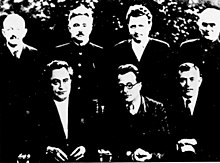Dmitry Manuilsky
Dmitriy Manuilsky | |
|---|---|
Дмитро Мануїльський | |
11th Central Committee | |
| In office 2 April 1922 – 25 April 1923 | |
| Personal details | |
| Born | 3 October 1883 RSDLP (Bolsheviks) (1904–1918) Russian Communist Party (1918–1954) |
| Alma mater | University of Paris |
| Awards | (×3) |
Dmitriy Zakharovich Manuilsky or Dmytro Zakharovych Manuilsky (
Early life and career

Manuilsky was born to a peasant family of an
In the Soviet Union

During the Russian Civil War, Manuilsky worked in the People's Commissariat for Food, before being sent to Ukraine, where Lenin assigned him the task of organising the peasant population around Kharkiv to defeat the White Army of Anton Denikin. In January 1919, he and Inessa Armand were sent to Paris, in the hope they could stoke a revolution in France, but he was arrested and deported. He was People's Commissar for Food in the Ukrainian Soviet Socialist Republic from 1920 to 1921, then switched to journalism, and from 1922 was working for the Comintern.
From 1923 to 1952 he was a member of the Central Committee of the Communist Party of the Soviet Union, as well as a member of the elite inner circle known as the "malaia comisiia", a five-member group that ruled the eleven-member Political Secretariat.[2] In 1926, he supplanted Nikolai Bukharin as leader of the Soviet Union delegation on Comintern's executive, and the lead representative at congresses of the French, German, and Czechoslovak communist parties.[3]
From 1935 until the dissolution of Comintern in 1943, he acted as deputy to its General Secretary, Georgi Dimitrov. Between 1944 and 1952, he held the largely meaningless post of Foreign Minister of Ukraine. From 1952 to 1953, he was Ukrainian ambassador to the United Nations.
Later life and career
During the
See also
- Mezhraiontsy
- Communist Party of Poland
- List of delegates of the 2nd Comintern congress
- List of national leaders of Ukraine
- Ukrainian SSR
- Lucrețiu Pătrășcanu
- Christian Rakovsky
- Permanent Representative of Ukraine to the United Nations
References
- ^ Manuilsky's biography from a 1920s edition of the Great Soviet Encyclopaedia is in translation in Haupt, Georges, and Marie, Jean-Jacques (1974). Makers of the Russian Revolution. London: George Allen & Unwin.
{{cite book}}: CS1 maint: multiple names: authors list (link) CS1 maint: numeric names: authors list (link) - ]
- ISBN 978-0801408090. Retrieved 21 December 2017.
- ISBN 0-300-09794-8.
- ^ Djilas, Milovan (1969). Conversations with Stalin. London: Penguin. pp. 28, 29.
External links
- Lenin, V. I. (22 February 1920). "Telegram to D. Z. Manuilsky". Marxists.org. Retrieved 25 November 2015.
- Walter Lacquer, Russia and Germany; A Century of Conflict, London, Weidenfeld and Nicolson 1965.
